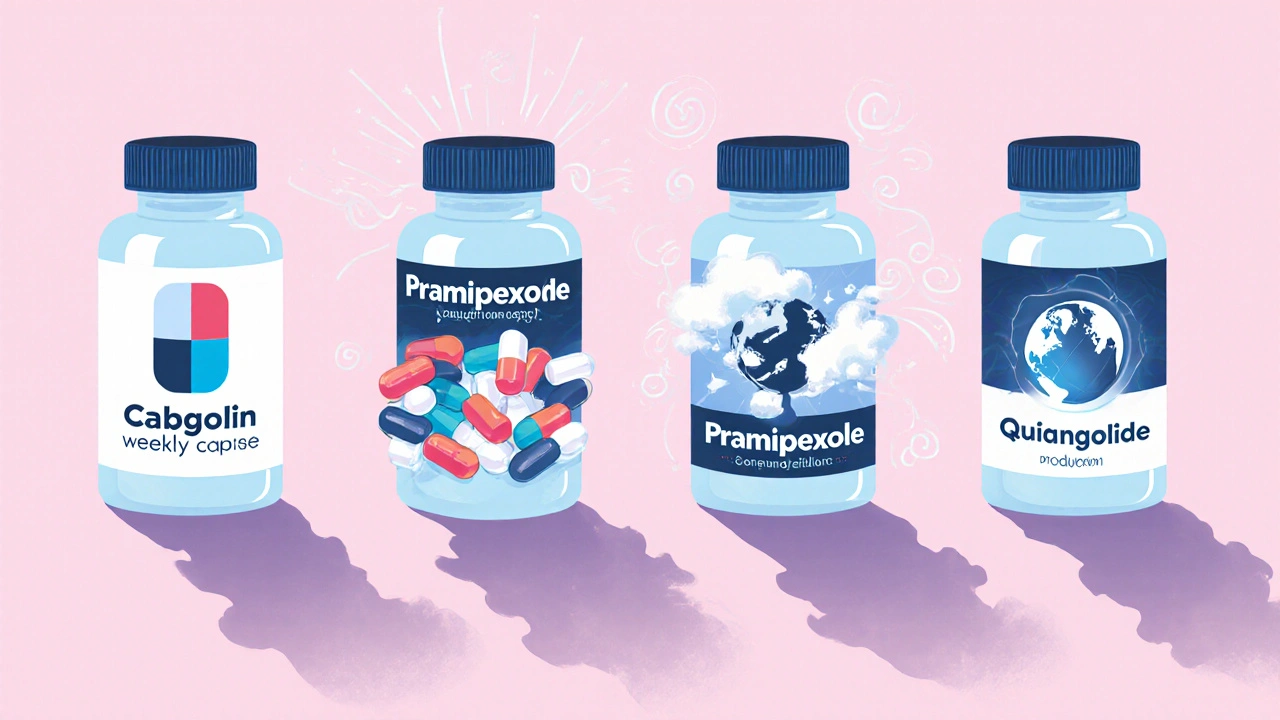High prolactin levels can cause infertility, irregular periods, low sex drive, and even milk production when you're not pregnant. For many, Cabgolin - the brand name for cabergoline - is the first drug doctors turn to. But it’s not the only option. Some people can’t tolerate it. Others find it doesn’t work well enough. And sometimes, cost or availability makes switching necessary. So what are the real alternatives to Cabgolin, and how do they stack up?
What Cabgolin (Cabergoline) Actually Does
Cabergoline is a dopamine agonist. That means it tricks your brain into thinking there’s more dopamine around. In the pituitary gland, dopamine naturally tells the body to stop making prolactin. So when you take cabergoline, prolactin drops - fast. For people with prolactinomas (benign tumors on the pituitary), it often shrinks the tumor. For those with high prolactin from other causes, it restores normal cycles and fertility.
It’s taken just once or twice a week. That’s a big plus. Most alternatives need daily doses. Cabergoline also has a long half-life - meaning it stays active in your body for days. This makes it more convenient and often more effective than older drugs.
But it’s not perfect. Side effects like nausea, dizziness, and low blood pressure are common at first. A small number of people report heart valve issues with long-term, high-dose use - though this is rare at the low doses used for prolactin control.
Alternative 1: Bromocriptine - The Original, But Harder to Tolerate
Bromocriptine was the first dopamine agonist used for prolactinomas. It’s been around since the 1970s. It works the same way as cabergoline - by activating dopamine receptors to lower prolactin.
But here’s the catch: you have to take it every day. Usually two to three times a day. That’s a hassle. And side effects? Much worse. Nausea, vomiting, constipation, and dizziness are common - often so bad that people stop taking it.
Studies show bromocriptine is just as effective as cabergoline at lowering prolactin and shrinking tumors. But in one 2021 review of 12 clinical trials, 68% of patients on bromocriptine reported intolerable side effects, compared to just 29% on cabergoline.
It’s cheaper. Much cheaper. In some countries, generic bromocriptine costs under $10 a month. Cabergoline can run $50-$100. So if you can handle the daily dosing and side effects, bromocriptine is a solid backup.
Alternative 2: Pramipexole - More for Parkinson’s, But Used Off-Label
Pramipexole is FDA-approved for Parkinson’s disease and restless legs syndrome. But doctors sometimes prescribe it off-label for high prolactin - especially if someone has both Parkinson’s and a prolactinoma.
It’s a dopamine agonist too, but it targets a different receptor than cabergoline. That means it’s less potent at lowering prolactin. In practice, it often doesn’t bring prolactin levels down as far or as fast.
It’s taken daily, usually two to three times a day. Side effects include dizziness, sleepiness, hallucinations, and impulse control issues - like compulsive gambling or shopping. These are rare but serious.
It’s not a first-line choice for prolactin alone. But if you’re already on pramipexole for Parkinson’s and suddenly develop high prolactin, your doctor might just adjust the dose instead of adding another drug.
Alternative 3: Quinagolide - The Less-Known Option
Quinagolide (brand name Norprolac) is another dopamine agonist. It’s not available everywhere - it’s approved in the UK, Canada, and parts of Europe, but not in the US.
Like cabergoline, it’s taken once daily. It lowers prolactin effectively and shrinks tumors. Some studies show it’s slightly less effective than cabergoline, but still better than bromocriptine.
Its side effect profile is similar to cabergoline: nausea, dizziness, fatigue. But because it’s cleared from the body faster, it might cause less long-term risk to heart valves.
If you’re outside the US and cabergoline isn’t working or causing side effects, quinagolide is a strong contender. It’s also used for women who want to get pregnant - because it doesn’t cross the placenta as much as bromocriptine.

Alternative 4: Surgery and Radiation - When Drugs Fail
Not all alternatives are pills. If drugs don’t work, or if the tumor is pressing on your optic nerve and threatening your vision, surgery might be needed.
Transsphenoidal surgery - through the nose - is the standard. It removes the tumor. Success rates are high for small tumors (over 80%), but lower for large ones. After surgery, prolactin often drops quickly, but you might still need medication to keep it low.
Radiation therapy is rare. It’s only used when surgery and drugs both fail. It takes years to work and can damage nearby brain tissue. It’s a last resort.
When to Switch from Cabgolin
You don’t need to switch just because you feel a little nauseous. Most side effects fade after a few weeks. Start low, go slow - take it with food, at bedtime, and give your body time.
But consider switching if:
- Your prolactin stays high after 3-6 months of treatment
- You develop severe nausea, low blood pressure, or fainting
- You’re trying to get pregnant and your doctor recommends a safer option
- Cost is a barrier and you can tolerate daily dosing
- You have heart valve disease or a family history of it
Never stop Cabgolin cold turkey. Suddenly stopping can cause prolactin to spike back up - sometimes higher than before. Always taper under medical supervision.
What About Natural Alternatives?
You’ll see online claims about vitamin B6, zinc, or chasteberry lowering prolactin. Some small studies suggest chasteberry (vitex) might help with mild PMS-related prolactin rise. But for true prolactinomas or clinically high levels? There’s no evidence it works.
Supplements can interfere with medications. Zinc can reduce absorption of bromocriptine. Chasteberry might make dopamine agonists less effective. Don’t rely on them. They’re not substitutes.

Choosing the Right Alternative - A Quick Guide
Here’s how the main options compare:
| Medication | Dosing | Effectiveness | Common Side Effects | Heart Risk | Cost (Monthly) |
|---|---|---|---|---|---|
| Cabergoline (Dopamine agonist used for prolactinomas and hyperprolactinemia) | 1-2 times per week | High | Nausea, dizziness, fatigue | Low (at standard doses) | $50-$100 |
| Bromocriptine (First dopamine agonist for prolactin; now mostly used when cost is critical) | 2-3 times daily | High | Nausea, vomiting, constipation, dizziness | Low | $10-$25 |
| Pramipexole (Used for Parkinson’s; off-label for prolactin) | 2-3 times daily | Moderate | Sleepiness, hallucinations, impulse control issues | Low | $40-$80 |
| Quinagolide (Dopamine agonist; available outside the US) | Once daily | High | Nausea, dizziness, fatigue | Very low | $60-$90 |
What Happens After You Switch?
Switching meds isn’t just swapping one pill for another. Your doctor will monitor your prolactin levels every 4-8 weeks. They’ll check for tumor size with MRI if you had a large one. They’ll also watch for new side effects.
Some people switch and feel better immediately. Others need a few months to stabilize. Don’t get discouraged if your prolactin doesn’t drop overnight. It’s a slow process.
And if you’re trying to get pregnant - whether on cabergoline or an alternative - your doctor will likely keep you on medication through early pregnancy. Stopping too soon can cause the tumor to grow or prolactin to spike.
Bottom Line: There’s No One-Size-Fits-All
Cabgolin is the gold standard for a reason: it’s effective, convenient, and well-tolerated by most. But it’s not the only path. Bromocriptine is cheaper and just as effective - if you can handle the daily doses. Quinagolide is a great option if you’re outside the US. Pramipexole has its place if you have Parkinson’s. Surgery or radiation? Only when drugs fail.
The key isn’t finding the ‘best’ drug. It’s finding the one that works for you - your body, your lifestyle, your budget, and your goals.
Work with your doctor. Track your symptoms. Don’t be afraid to ask for alternatives. You deserve a treatment plan that fits your life - not the other way around.
Can I switch from Cabgolin to bromocriptine on my own?
No. Never switch dopamine agonists without medical supervision. Stopping cabergoline suddenly can cause prolactin to rebound sharply, worsening symptoms or triggering tumor growth. Your doctor will create a tapering plan and start the new medication gradually while monitoring your prolactin levels.
Is Cabgolin safe during pregnancy?
Yes. Cabergoline is considered safe to use during early pregnancy for women with prolactinomas. In fact, it’s often continued through the first trimester to prevent tumor growth. Most doctors switch to bromocriptine after the first 3 months because it has more long-term safety data in pregnancy, but many continue cabergoline without issue. Always follow your OB-GYN’s guidance.
Do natural remedies like chasteberry really lower prolactin?
No reliable evidence shows chasteberry or other supplements can lower prolactin in people with true hyperprolactinemia or prolactinomas. Some small studies suggest mild effects for PMS-related symptoms, but they’re not strong enough to replace medication. Supplements can also interfere with prescription drugs, so always tell your doctor what you’re taking.
Why is Cabgolin so expensive compared to bromocriptine?
Cabergoline is still under patent protection in many countries, which keeps prices high. Bromocriptine has been generic for decades, so it’s produced by many manufacturers, driving the price down. Insurance coverage varies - some plans cover cabergoline only after trying bromocriptine first. Always ask your pharmacy about generic options or patient assistance programs.
Can Cabgolin cause heart problems?
High doses of cabergoline (over 3 mg per week) used for Parkinson’s have been linked to heart valve thickening in rare cases. But for prolactinoma treatment, the dose is usually 0.5-1 mg per week - far below the risky level. Studies show no increased risk at these doses. Still, if you have a history of heart valve disease, your doctor may choose bromocriptine or quinagolide instead.



Just wanted to say thank you for this breakdown - seriously, this is the most helpful thing I’ve read all year. I was on Cabgolin for 8 months and thought I was alone in the nausea spiral. Turns out, I just needed to know bromocriptine was an option. Started it last month, took it with a peanut butter sandwich at bedtime, and boom - no more vomiting at 3 a.m. 🙌 Also, my prolactin dropped from 120 to 18 in 6 weeks. I’m not crying, you’re crying.
Supplements don’t work. Stop wasting your money.
Wow, so you’re telling me people actually listen to doctors? How quaint. I’ve been taking ashwagandha and cold showers for 2 years and my prolactin’s ‘fine’ - whatever that means. Also, why are we letting Big Pharma decide what we take? #FreeThePituitary
Okay but like… why is everyone acting like bromocriptine is the devil?? I took it for 6 months and it was fine. I just ate a banana before each pill and my nausea vanished. Also, I got pregnant on it. So stop being dramatic. Also also, Cabgolin made me feel like a zombie. I’d rather be nauseous and fertile than numb and broke 💅
It’s essential to recognize that the pharmacological management of hyperprolactinemia must be individualized based on patient-specific factors including but not limited to: comorbidities, reproductive goals, pharmacokinetic profiles, cost accessibility, and long-term safety data. While cabergoline remains the first-line agent due to its superior tolerability and dosing convenience, the utility of bromocriptine in resource-limited settings or for patients requiring pregnancy-compatible regimens cannot be understated. Furthermore, the off-label use of pramipexole should be reserved for patients with concomitant Parkinsonian symptoms, given its distinct receptor affinity and potential for impulse control disorders. Quinagolide, though unavailable in the U.S., offers a compelling alternative for international patients due to its favorable cardiac safety profile and once-daily administration. Surgical intervention remains a critical option for compressive lesions, and radiation therapy should be considered only after multimodal medical failure. Crucially, abrupt discontinuation of dopamine agonists carries significant risk of rebound hyperprolactinemia and tumor expansion - therefore, any transition must be medically supervised with serial prolactin monitoring and, where indicated, neuroimaging. Natural supplements lack robust evidence and may interfere with pharmacodynamic efficacy; therefore, their use should be discouraged in clinical contexts where pharmacotherapy is indicated.
How refreshing to see a medical article that doesn’t read like a pharmaceutical brochure. Truly, the fact that bromocriptine costs $10 a month while Cabgolin costs $100 is not a feature - it’s a scandal. And yet, we’re told to ‘talk to your doctor’ as if they’re not paid by the same companies that make the expensive pill. The real alternative? A healthcare system that doesn’t treat patients like ATM machines. Also, quinagolide being unavailable in the U.S.? That’s not a medical decision. That’s a corporate one. Sigh.
Ugh. I read the whole thing. And you still didn’t mention that Cabgolin gave me depression. Like, full-on suicidal ideation. No one talks about that. Just ‘nausea and dizziness.’ Cool. Thanks for the info, I guess. 🙄
bro i just took vitamin b6 and now my prolactin’s normal. you’re all overthinking this. also why are you all on reddit talking about your hormones like it’s a podcast?